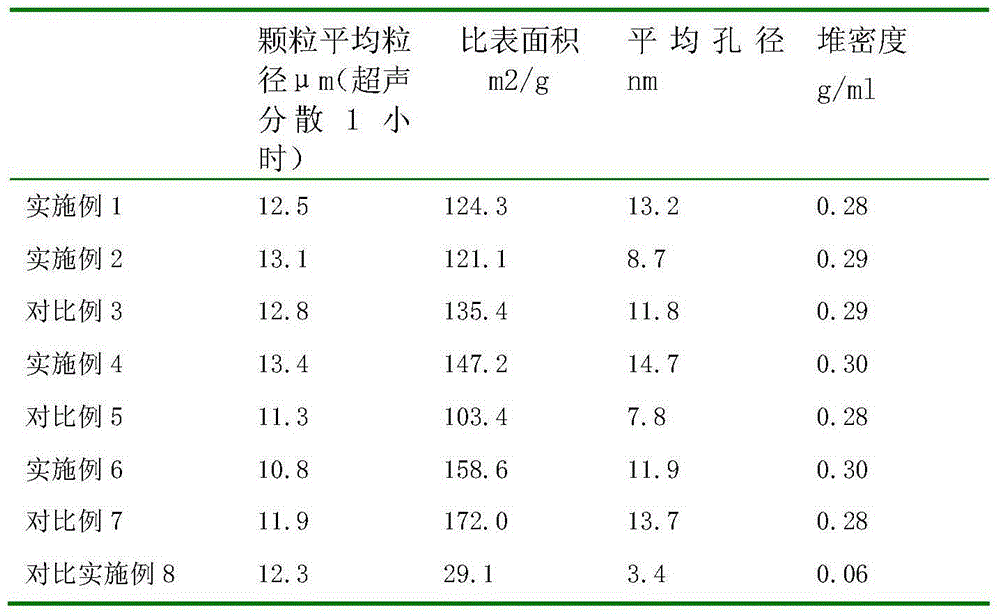Method for preparing terpolymer for carrier of olefin polymerization catalyst
A carrier and monomer technology, which is applied in the field of terpolymer preparation, can solve the problems of uncontrollable particle specific surface area and average pore size, unfavorable metallocene catalyst loading, and small particle size of polymer particles, so as to achieve uniform size, The effect of low inorganic ash content and narrow dispersion
- Summary
- Abstract
- Description
- Claims
- Application Information
AI Technical Summary
Problems solved by technology
Method used
Image
Examples
Embodiment 1
[0018] Preparation of organic porous carrier:
[0019] Treatment of reactive monomers: styrene and divinylbenzene are removed with 10% NaOH solution before use, and then washed with deionized water for 3 times before use. Hydroxyethyl methacrylate is chromatographed using neutral alumina The column was used after removing the polymerization inhibitor. Unless otherwise specified below, the reactive monomers are all used after pretreatment.
[0020] In a 250ml glass reactor, add 120ml ethanol and 12ml deionized water, then add 4ml (about 3.8g) styrene and 4ml hydroxyethyl methacrylate (about 4.0g), stir at room temperature for 5min, then add 2% Polyvinyl alcohol (polymerization degree: 1750) in monomer mass, stirred at 45°C for 1 hour, dissolved the polyvinyl alcohol stabilizer, then added 10ml DNBP, and 1.5% monomer mass of AIBN, raised the temperature to 50°C, and reacted 2 hour, then add 4ml (about 3.9g) of divinylbenzene, rise to 70°C, react for 3 hours, and then age at 80...
Embodiment 2
[0022] Preparation of organic porous support: In a 250ml glass reactor, add 108ml of ethanol and 12ml of deionized water, then add 3ml (about 2.7g) of styrene and 2ml of hydroxyethyl methacrylate (about 2.0g). Stir at room temperature for 5 minutes, then add 2% polyvinyl alcohol (polymerization degree: 1750) of the monomer mass, and stir for 1 hour at 45°C to dissolve the polyvinyl alcohol stabilizer, then add 4ml DNBP, and 1.5% monomer mass AIBN, reacted at 50°C for 1 hour, added 3ml of 55% (about 2.8g) divinylbenzene, raised the temperature to 70°C, reacted for 3 hours, then raised the temperature to 80°C, reacted for 5 hours, and the stirring speed was 600 rpm minutes, washed 3 times with ethanol, and dried to obtain a porous organic carrier.
Embodiment 3
[0024] The preparation of the organic porous carrier in Example 3 is the same as in Example 2 except that the amount of porogen used is different, and the preparation steps are the same as the amount of other reagents. In Example 3, 7ml DNBP was added instead of 4ml DNBP.
PUM
| Property | Measurement | Unit |
|---|---|---|
| degree of polymerization | aaaaa | aaaaa |
Abstract
Description
Claims
Application Information
 Login to View More
Login to View More - R&D
- Intellectual Property
- Life Sciences
- Materials
- Tech Scout
- Unparalleled Data Quality
- Higher Quality Content
- 60% Fewer Hallucinations
Browse by: Latest US Patents, China's latest patents, Technical Efficacy Thesaurus, Application Domain, Technology Topic, Popular Technical Reports.
© 2025 PatSnap. All rights reserved.Legal|Privacy policy|Modern Slavery Act Transparency Statement|Sitemap|About US| Contact US: help@patsnap.com

